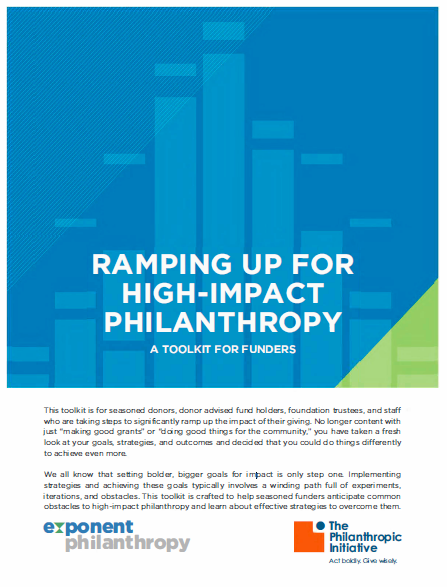This post is part of the Ramping Up for Impact blog series, which digs deeper into topics explored in the primer by The Philanthropic Initiative (TPI) and Exponent Philanthropy, Ramping Up Your Foundation: Key Considerations for Planning and Managing a Significant Increase in Giving. Click here to download the guide through Exponent Philanthropy’s website.
—
Foundations boards tend to put their greatest time and energy into grantmaking. However, the reality is that it is even more important for foundation boards to focus on their own governance and operations. Boards are legally responsible for financial stewardship and compliance issues, they drive critical strategic planning work, and they hire and fire executive staff. They also must ensure that they operate effectively and prepare for their own succession. Ramping up to incorporate greater assets provides an opportunity – really a mandate – for foundations to focus on these important roles and rethink their governance.
This “rethinking” can manifest in a few different ways. It could be a series of strategic planning sessions or a retreat that allows a board to step back and consider what the foundation needs for the next stage. Often precipitated by the passing of a donor, a ramp-up is likely an opportune time to reassess the composition and size of the board and involve new voices. It is a perfect time to develop or refine policies, and to codify processes and agreements that were previously informally understood or need updating. For foundations that are hiring their first staff or expanding the staff significantly, it is often a time to clarify the board’s role in day to day operations. Some foundation boards use this inflection point as an opportunity to develop or revise a formal governance plan.
All of these possibilities should be considered by the Board Chair of a foundation undergoing a ramp-up, although not all may be needed, and the sequence of actions will vary from foundation to foundation. However, the need to thoughtfully prepare and engage the full board in the planning process is universal.
In our work at The Philanthropic Initiative (TPI), we often see the need for foundations to professionalize their governance at this stage in their development. Some foundations carefully document each evolution of how the board operates, while others tend to pass down traditions in a manner akin to family lore. Now is the time to document the norms tacitly understood by the current generation of board and staff, revisit or establish standard policies (e.g., conflict of interest policy, expenses policy, investment policy, etc.), agree on written job descriptions for directors and officers, and codify operating procedures. Create a “trustee handbook” that includes all relevant documents, and responds to the question, “What information would a new board member need in order to understand how we work together?” For example:
- What are the norms around decision-making and when may a vote be called?
- What is the process for assessing and awarding grants?
- What has the board determined for succession planning?
- What was the donor’s intent and how is the current board choosing to honor that legacy?
Ramp-ups often require a mind shift change for a foundation’s governing body. Founding boards tend to be deeply involved in all aspects of a foundation’s life and may even act as volunteer staff in such areas as sourcing grantees, communicating with applicants and awardees, and managing endowments. An increase in size brings the opportunity for staff support as well as for a commensurate shift in the role of board members to focus on high level strategy, stewardship, compliance, and oversight. Making that shift can be difficult for some boards or for their individual members who have enjoyed being deep in the work.
One of TPI’s clients struggled mightily to make this shift to a more professionalized role in governance as they ramped up. Spreadsheets laying out respective accountabilities were developed, experts and peer foundation speakers were brought in to share their insights, and job descriptions were crafted for new staff and the board. A strengthened governance committee did its best to “rein in” rogue board members who couldn’t resist talking to grant prospects and partners. The board engaged in a reflection on their culture and defined “what needed to change.” Change came slowly and was ultimately led by new board members who came in with a different mindset.
The ramping up process is a major transition in the lifecycle of a foundation. It can be a rewarding experience, often accompanied by some surprises, changing roles and responsibilities, and the possibility of new staff and board members. Seizing the opportunity to rethink a foundation’s governance will help mitigate future conflicts and pave the way for successful transitions.
—
TPI has worked with a number of families, foundations, and corporations at various points in the ramping up process, helping these clients successfully navigate the challenges that come with this transition. To learn more about our client work in this area, or if you are interested in engaging TPI’s consulting practice, please contact Ellen Remmer at eremmer@tpi.org.


